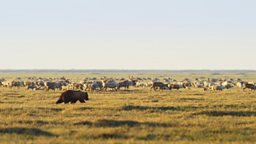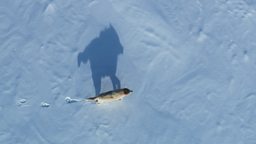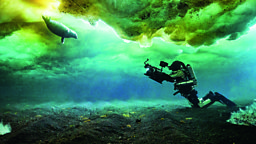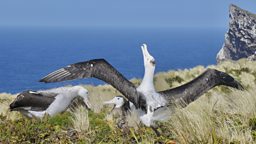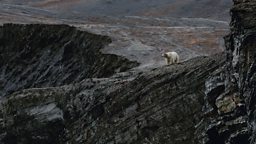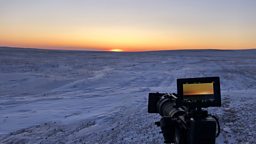‘It’s all about privileged glimpses into the natural world’
By Jane Atkins, Producer for Frozen Planet II
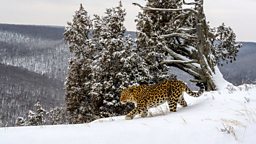
it’s only possible by teaming up with scientists in the field who have unique access
As a producer on Frozen Planet II, you have a blank canvas at the start of the project and by the end need to deliver something that is beautiful, but also rich, dramatic, with a lovely range of characters and emotions. To create those moments of surprise though, you really need to work out how to give audiences those privileged glimpses into the natural world. Whether it’s using aerials to follow a super-pack of wolves strategically hunting, camera trap footage blended to show Amur leopards and tigers walking in each other’s footprints, or using a highly light sensitive camera to film a bumblebee queen, in near darkness, building nectar pots and incubating her eggs, it’s all about revealing secret worlds. More often than not, it’s only possible by teaming up with scientists in the field who have unique access through their own work.
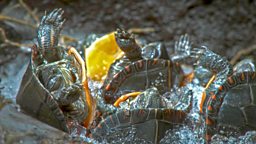
tiny painted turtle hatchlings – each as small as a 50 pence piece
One such opportunity came about when we started talking to Dr Patrick Baker, an Associate Professor, who has studied reptiles for 30 years – and led the way in research on painted turtles. He showed us drawn images of tiny painted turtle hatchlings – each as small as a 50 pence piece, huddling in a nest together underground as winter set in, like kids huddling for warmth around a fire. Patrick described how as winter arrived, the soil around them would freeze, locking them into their nests for 6 months, with no food or water. As if that wasn’t enough, the freezing temperatures completely changed their metabolism, to the point that their hearts stopped beating, and only their brains remained faintly active. I was fascinated about this little known story, and decided to try to film it as perhaps the most extreme example of ‘hibernation’ in the frozen world.
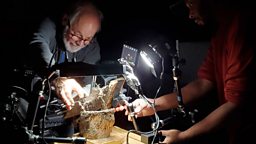
With the miniature forest studio ready, the magic began!
We knew we would need Patrick’s expertise, as he had years of data on exact temperatures that the turtles would tolerate through the cold, and then ‘wake up to’. With his guidance, the camera team built a ‘studio’ nest in a cabin in the forest near the border of America and Canada - near where the turtles would naturally live. The crew prepared their cameras and lights whilst Patrick advised on the time frame we had to get each shot based on temperature response. Patrick had, 6 months earlier, in the Autumn, already collected the hatchlings from his study site, and had kept them for us, so he was ready with the collection of baby turtles all in deep winter sleep! With the miniature forest studio ready, the magic began! Patrick positioned the turtles in a way that was true to nature, managing the temperature precisely, whilst Michael Male and his assistant Brandon Sergeant filmed some beautiful reveals of the hatchlings huddled in the ice. It was a great start, but for me the most fascinating moments were when the temperatures were raised to around 0°C, and the turtles started to move for the first time in months. It was like a spell being lifted. To see them stretch, open their eyes and take long deep breaths in spring was incredible because it seems to defy the common laws of nature! After their spring thaw the hatchlings were safely returned to their study site in the wild.

surprising new insights and moments that add colour to some of the bigger spectacles of the series
It's these surprising new insights and moments that add colour to some of the bigger spectacles of the series. Another opportunity came when we were contacted by a team of scientists from the Laval University and the Canadian Museum of Nature working out of the Canadian High Arctic Research Scientific Base (CHARS). Two scientists, Dominique and Mathilde were planning on observing lemmings and their ability to dig through different types of snow to better understand how this might affect their metabolism and predicted survival in winter. This was of particular interest to them because snow conditions are changing in the Arctic across the year due to climate change and lemmings are the main source of food for animals like Arctic foxes and snowy owls. We were keen to also film the lemmings as this gave a fresh take on the story of Arctic foxes trying to catch them, so we accepted the invitation and headed north!
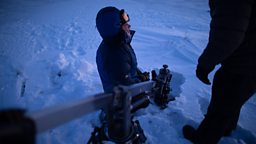
It’s by far the coldest place I’ve ever been!
Getting off the flight in Cambridge Bay, Nunavut, Canada, we were hit by the freezing winter conditions – the air was so cold it took your breath away. It’s by far the coldest place I’ve ever been! It was late November and the sun had disappeared for winter, providing only a few hours of light a day. With windchill, the temperatures here regularly drop to -50 degrees, so spending any time outside demanded every inch of skin be covered up to protect from instant pain and frost-bite. Filming the lemmings in the wild, under the snow in such extreme conditions, was simply not feasible, so we worked alongside the scientists at their indoor facility at CHARS to create snow tunnels in which to film them. Nevertheless, the temperatures were still very low, so we filmed wearing hugely padded clothing and boots.
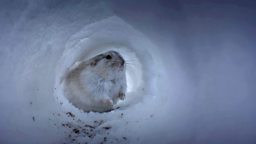
a fantastic collaboration, giving another privileged insight into an unseen world
All the while the lemmings seemed as happy as anything, munching food in the tunnels, digging, and even mating. The scientists during their earlier studies had observed that the lemmings’ claws grew longer and hairier through winter to facilitate digging through snow, and now moved at ease in the snow tunnels. They also measured the temperatures the lemmings tolerated – and discovered that snow actually acted like a blanket for them, keeping their tunnels far warmer than life at the surface. The scientists found that in normal conditions, soft and wind-hardened snow is no challenge for the lemmings to dig into. However, they also simulated snow hardened by rain-on-snow events, which are more susceptible to occur in the Arctic due to a warming climate. They observed that the lemmings had to work harder to dig through these types of snow, which is thought to have a negative impact on their reproduction and survival through the subsequent seasons. Mathilde said to us ‘We were glad that the Â鶹ԼÅÄ team looked for collaboration opportunities to educate the public, but also promote our science and showed trust in our research for all behavioural aspects of the animal as well as their well-being during the filming.’ Sharing the footage and knowledge each day with the scientists was really fascinating, and a fantastic collaboration, giving another privileged insight into an unseen world.

